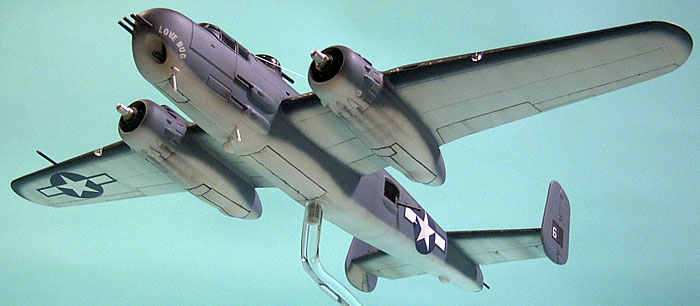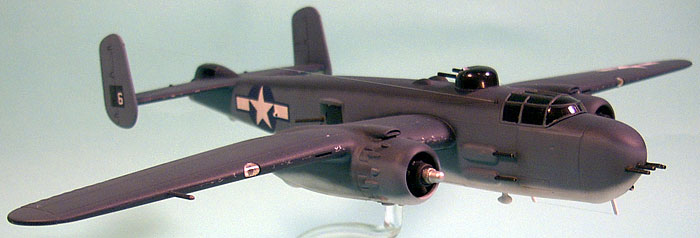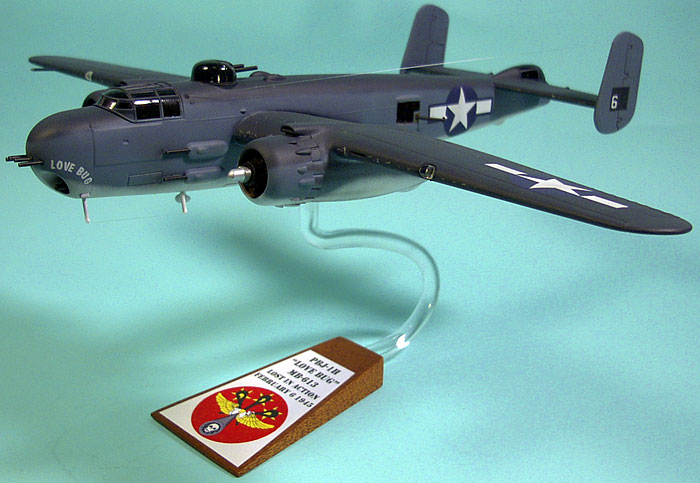|
Matchbox "Classic" 1/72
scale B-25
PBJ-1H “Love Bug”
by Tory Mucaro
|
 |
|
North American
PBJ-1H
“Love Bug” |

HyperScale is proudly supported by
Squadron.com
The PBJ-1H is the Marines equivalent of the B-25H.
Only one Marine squadron used the “H” model operationally, and that
was VMB-613. Unfortunately, they encountered the same problem with the
type as the Air Force - a lack of suitable targets for the big 75mm gun.
However, the type remained in service until the end of the war.

The aircraft I chose to model is BuNo 35275, MB-6 “Love Bug” flown by
First Lieutenant William J. Love. This aircraft was lost on February 6,
1945 during a hunter-killer mission. Six planes conducted a strike
against Airfield Number Two on Ponape Island. “Love Bug” was lost to
enemy fire, killing the entire crew of six. The wreck of this aircraft
was discovered in July of 2001. For more information on VMB-613, check
out this excellent website:
http://www.vmb-613.com/
I started with the classic (which is just another word for old)
Matchbox kit.
The reason I used this kit instead of a Hasegawa or Italeri kit was
that I discovered the poor little thing sitting on the shelf of my local
hobby shop, Jersey Shore Hobbies. It was part of a private collection
being sold off. I suspected no “serious” modeler would ever even
consider buying, let alone building it. So I handed over the $10.00
being asked for it and set forth to attempt to turn it into something
presentable.
Upon opening the box I discovered why “serious” modelers avoid this
kit. It is a very basic, somewhat inconsistent kit. The wings have very
deep recessed panel lines while the fuselage has very fine raised panel
lines. I have no idea what the designers at Matchbox were thinking when
the set about tooling up this one.

Also, there was no interior detail to speak of, save a few crew
members and some basic furniture. And don’t even ask about the landing
gear!
So I decided to go the desk top model route with it and build it gear up
(my favorite way to display aircraft anyhow) and with blacked out
transparencies. It was built pretty much out of the box with one
exception. After getting the model home I discovered the tail gunner’s
transparency was missing. After an ill-fated attempt to secure a
replacement, I wound up fashioning one from a piece of scrap acrylic.
 Once assembled the model was given a coat of Plasticote Auto Primer
and all gaps filled and sanded. Then I applied Krylon Flat White for the
underside color. Once assembled the model was given a coat of Plasticote Auto Primer
and all gaps filled and sanded. Then I applied Krylon Flat White for the
underside color.
Once this was dry, I airbrushed Model Master Non-specular Sea Blue on
the upper surfaces. Model Master Intermediate Blue was then airbrushed
on all the vertical surfaces last. The model was clear coated with Polly
Scale Gloss Clear and decals from Aeromaster were applied for the
insignia.
The tail numbers were fashioned from Microscale Black Decal Film and
the number six came from a Microscale Atlantic Coast Line railroad decal
sheet.
The “Love Bug” was applied using Archer Dry Transfers lettering. The
antennae wires are stretched clear runners (not sprue as is often
reported!) from the kit’s clear parts.

Weathering was accomplished with Floquil Grimy Black thinned and
airbrushed as well as some light pastel application.
Some paint chipping was added with Testor's Steel (sliver always
looks to bright for chipping). No pre or post shading was done.
The stand is made from a scrap of mahogany cut, sanded and clear coated
with a heated and shaped piece of clear Ľ inch acrylic rod inserted. The
name plate was created using squadron insignia art obtained from the
aforementioned website in Microsoft word, printed out, trimmed and spray
mounted to the base.
And that’s about it.
I must admit that I prefer the B-25 in the Navy’s tri-color camo. It
just works with the lines of the aircraft. And who could resist all
those guns?
Semper Fi!
Click on the thumbnails
below to view larger images:
Model, Images and Text Copyright ©
2006 by Tory Mucaro
Page Created 18 December, 2006
Last Updated
21 February, 2007
Back to
HyperScale Main Page |
Home
| What's New |
Features |
Gallery |
Reviews |
Reference |
Forum |
Search